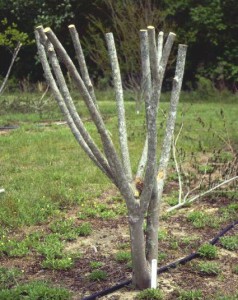This is the time of year when we often see crapemyrtles unnecessarily topped: main stems that are several years old are cut back, often leaving branch stubs 2 – 5 inches or more in diameter. Topping is sometimes called heading, stubbing, rounding and dehorning.

Figure 1. Topping is the drastic removal of large-diameter wood (typically several years old) with the end result of shortening all stems and branches. Topping crapemyrtle is often referred to as “crape murder” because topping usually is not recommended for crapemyrtle. Image Credit Dr. Gary Knox

Figure 2. Topping is the drastic removal of large-diameter wood (typically several years old) with the end result of shortening all stems and branches. Topping crapemyrtle is often referred to as “crape murder” because topping usually is not recommended for crapemyrtle. Image Credit Dr. Gary Knox
In the case of crapemyrtles, another name for this practice is “crape murder”. Topping a crapemyrtle is almost always unnecessary. Because people have seen this done in previous years, home owners often mimic this practice in their own yards, not realizing the unfortunate consequences.
Research at the University of Florida, detailed in this linked publication, found that topping crapemyrtle (“crape murder”) delays flowering up to one month. In other words, unpruned trees may begin flowering in June whereas topped trees don’t flower until July. This research also found topping reduced the number of flowers and shortened the flowering season. Finally, topping stimulated more summer sprouting from roots and stems. Sprouting results in greater maintenance since sprouts are usually removed to maintain an attractive plant appearance.
Unfortunately, landscape professionals and home owners often must maintain crapemyrtles that others planted, and so must deal with the consequences of poor cultivar selection and/or placement. If a crapemyrtle requires routine pruning to fit into its surroundings, it should be replaced with a smaller maturing cultivar. Dwarf crapemyrtles mature at a height of 5 feet; medium crapemyrtle cultivars grow up to about 15 feet in height, and tall or tree-size crapemyrtle cultivars exceed 15 feet and often grow to 20 – 30 feet tall in 10 years.
Best locations for crapemyrtle are areas in full sun with plenty of room for the cultivar size and away from walkways and roads. Proper selection of crapemyrtle cultivar and proper placement in the landscape can result in a low maintenance crapemyrtle without the need for significant pruning.

Figure 3. With proper cultivar selection and placement in the landscape, crapemyrtle develops into a beautifully shaped tree that rarely needs pruning. This crapemyrtle is ‘Muskogee’. Image Credit Gary Knox
For more information, see ENH1138, Crapemyrtle Pruning.
- Foodscaping – Create Beauty and Bounty - April 7, 2022
- Cold-hardy Bromeliads for North Florida - December 15, 2021
- How to Hunt for “New” Plants - September 2, 2021
